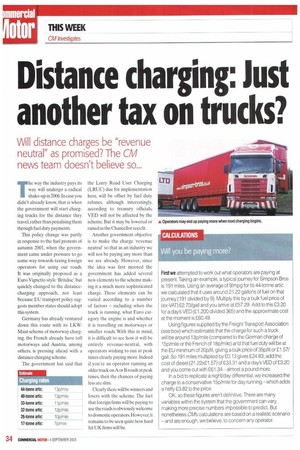LI1uI •111010 t■M
Page 34

If you've noticed an error in this article please click here to report it so we can fix it.
Will you be paying more?
First we attempted to work out what operators are paying at present. Taking an example, a typical journey for Simpson Bros is 191 miles. Using an average of 9/mpg for its 44-tonne artic we calculated that it uses around 21.22 gallons of fuel on that journey (191 divided by 9). Multiply this by a bulk fuel price of (ex-VAT) £2.70/gall and you arrive at £57,29. Add to this £3.20 for a day's VED (£1,200 divided 365) and the approximate cost at the moment is £60.49.
Using figures supplied by the Freight Transport Association (see box) which estimates that the charge for such a truck will be around 13p/mile (compared to the German charge of 15p/mile or the French of 18p/mile) and that fuel duty will be at the EU minimum of 20p/lit, giving a bulk price of 35p/lit or £1.57/ gall. So 191 miles multiplied by £0.13 gives £24.83, add the cost of diesel (21.22x£1.57) of £33.31 and a day's VED of £3.20 and you come out with £61.34 —almost a pound more.
In a bid to replicate a night/day differential, we increased the charge to a conservative 15p/mile for day running —which adds a hefty £3.82 to the price.
OK, so these figures aren't definitive. There are many variables within the system that the government can vary, making more precise numbers impossible to predict. But nonetheless CMs calculations are based on a realistic scenario — and are enough, we believe, to concern any operator.
















































































































































































































